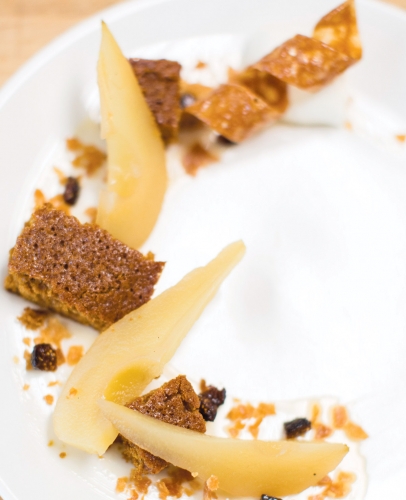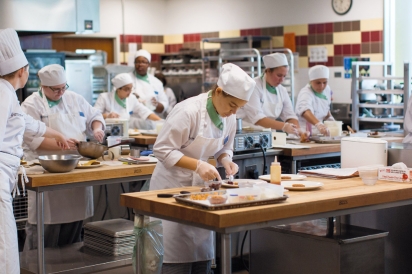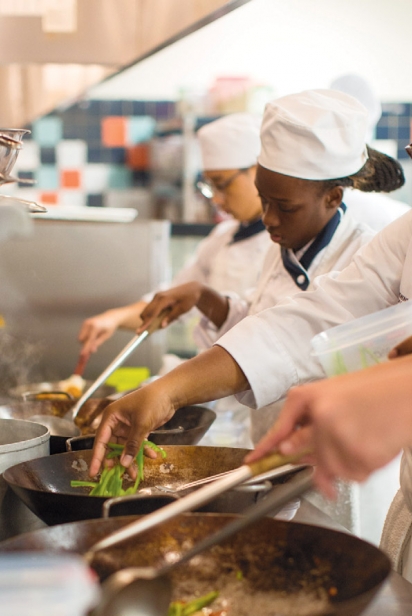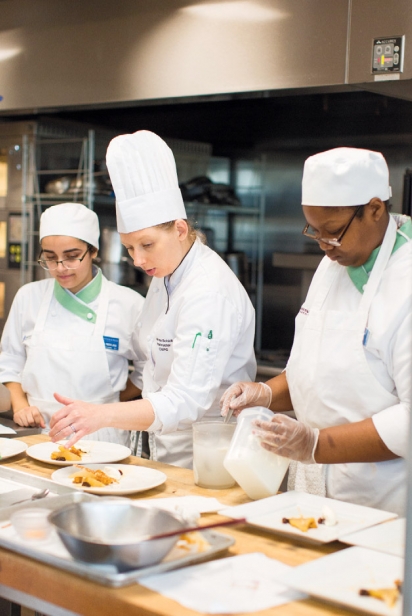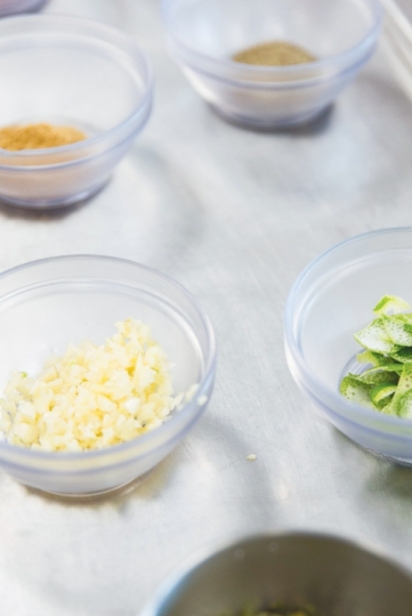In Favor of Flavor
Future Chefs Put Their Noses (and Taste Buds) to the Grindstone at JWU
“Put away your scales. Put away your mixers,” Chef Jaime Schick commands from the helm of her kitchen classroom inside the glass-encased Cuisinart Center for Culinary Excellence at Johnson & Wales University’s (JWU) Harborside campus in Providence. The 16 fresh-faced students, clad in their mandatory pristine double-breasted chef jackets, chef hats and checked slacks, scurry about furiously and gather around the table. They are here for Day One, the first in a multi-day series of chef-led intensives exploring all facets of culinary education.
Chef Schick’s students are here for “Plated Desserts,” where they are learning the fundamentals of crafting upscale desserts and how to serve the sweet or savory final course in a way that simultaneously captivates the eyes, nose and palate.
“Flavor is our number one reason for putting anything on a plate,” she says. She then shows the students pieces of orange on a plate, pointing out that, while delicious, the fruit is big, bulky and pithy. “It doesn’t look refined, does it?” Schick asks.
The students agree and Chef shows the inquisitive minds different ways of presenting the fruit in an artful but mouthwatering manner. With a hand-held blowtorch, she gently chars the orange segments, showing the students how the treatment completely changes the look of the fruit, then has them taste. “The char will add visual interest and give the fruit a mild campfire flavor,” she explains. She then passes around orange segments that have been infused with rosemary to exhibit a completely different flavor profile of the same fruit. “We can always take it up a notch.”
For most first-year students, the culinary curriculum is new territory. “We slide into it very slowly and it progresses with every class. They are learning to walk before they run,” says Chef John Dion, who has been mentoring young minds at JWU for 38 years and, he adds, “I still enjoy teaching every single day.”
While Dion and his colleagues are tasked with teaching the breadth of how to cook—from which ingredients are used, to what cooking tools are needed, to how cooking methods greatly impact every facet of a dish—they are also challenged with how to teach them something much more subjective: flavor.
“We teach them to hone in on the five flavors: sweet, salty, sour, bitter and umami,” Dion says. “We’ll have them toast a spice and tell them to smell, asking ‘Do you pick up sweet or nutty? Is it burnt?’” The students, he explains, can master a recipe but as they advance, they begin to better think about their food. “The flavor combination of taste and aroma is trigeminal. It has to do with the trigeminal nerve…when you taste something and have a physical reaction to it.”
How does he teach the skill of developing a confident palate and mastering flavor?
“Taste, taste, taste,” he says.
In 2010, food scientist Harold McGee released Keys to Good Cooking: A Guide to Making the Best Foods and Recipes (Penguin Press). Considered the foremost expert on the science of cooking, McGee wrote, “Flavor is a combination of taste and smell. We sense taste on the tongue, and smell, or aroma, in the nose.”
At JWU, Dion exercises the tongue and nose constantly in his Science of Cooking & Sensory Analysis class by challenging his students, assigned to small groups, to create a wide spectrum of from-scratch, flavor-forward dishes. On one early October morning, a focused trio plans their strategy for making Robatayaki-style grilled chicken and mushroom skewers, only they must prepare the Japanese dish cooked three different ways: charcoal grilled, gas grilled and baked.
John Laurent, a first-year student, is foiling a pan for the charcoal-grilled method. He says he’s been cooking since he was 10. “I cooked with my mom all the time. She’s a really good cook,” he says with a megawatt smile. Though he worked in a restaurant for about two years, he describes his training at JWU as “more formal.” Later, Dion instructs him to place a few briquettes directly on the flame of the gas stove. After a few minutes, he transfers them into the pan, places the grill on top and as he lays the chicken skewers down, the meat sizzles and the unmistakable smell of summer wafts about.
On the other side of the classroom, students are sautéing the garlic they just finely minced in olive oil for the Camarones y Ajo (shrimp and garlic) dish. Others are busy combining freshly ground coriander seed, annatto seed, cumin, onion powder, black pepper and sea salt to make sazón seasoning for Latin rice, and another group is preparing Drunken Noodles with garlic, Thai chilies, red bell peppers, fish sauce, soy sauce, sugar, tomatoes, Anaheim chili, pepper and Thai basil. Throughout the entire half-day session, Dion projects repeatedly, “Is everyone feeling that aroma? Is everyone using their nose?”
McGee would applaud Dion’s approach. The author notably wrote that everyone tastes and smells differently because the receptors that take in the compounds that have flavor or aroma in our mouths and noses vary greatly.
Back in Chef Schick’s kitchen, students taste raw walnuts and describe the flavor. “Starchy,” “bitter” and “tastes old,” are offered up. She then toasts the walnuts, rendering the oils which produces, according to the students, “nuttier” and “more complex” flavors. Chef places another heap of walnuts into a pot and adds confectionary sugar, salt and spices, constantly mixing the ingredients over medium heat.
The classroom is soon engulfed in warm, sweet aromas. “The darker the caramel gets, the more flavor you’re imparting,” she explains. Chef points out that adding honey or vanilla extract will additionally modify the flavors, confirming her belief that flavor is built, witheach modification adding depth and dimension, and illustrates how simple decisions like what type of salt you use can greatly alter your dish. Bitter or sweet, crunchy or salty, a walnut that transforms from raw to toasted to a candied delight exhibits a host of vastly different flavors. But one thing she knows for sure: “Tell me if this is not the most delicious nut you’ve ever had.”
“It’s a whole sensory experience. What’s the mouth feeling? If the balance of fat and salt and acid is all there—it’s a whole sensory piece,” says Maureen Pothier, chair of JWU’s Culinary Arts program. “Your palate plays a huge part in it, your sense of smell plays a huge part in it, even hearing it … hearing that great sizzle of steak. We work constantly with our students to develop their whole sensory.” Pothier says that the program’s segments are like building blocks, with each step concentrating on a specific area of the culinary arts (including food science, beverages and front of house).
“The difficulty is, you can’t possibly give the student everything you want to in each segment,” she explains, but by gathering after every class for a family-style meal, tasting a bevy of dishes prepared in a variety of methods and discussing what they are tasting, what they are smelling, what they are feeling, they are constantly developing.
“[They] talk about it, what they did and how they could intensify this or lessen the intensity of that. I say it’s building a little filing cabinet in your head … it’s a constant build. We are all constantly learning. When they are graduating, we still remind them, they don’t know everything, nor will they stop learning.” With all the encouragement students are given to experiment with food, are there any mistakes in the kitchen classrooms? Pothier answers, “Only the ones they don’t learn from.”


